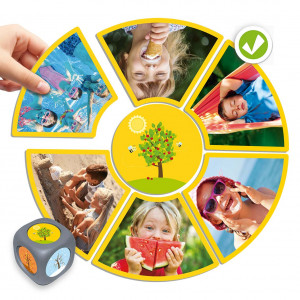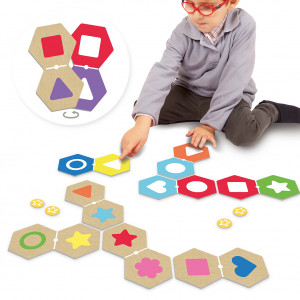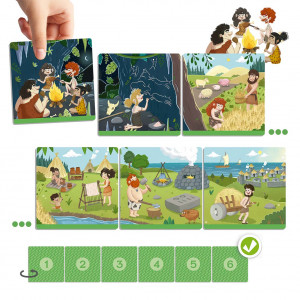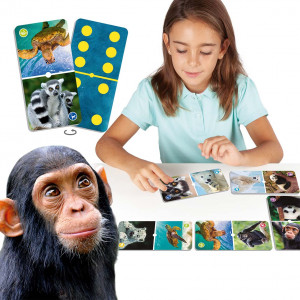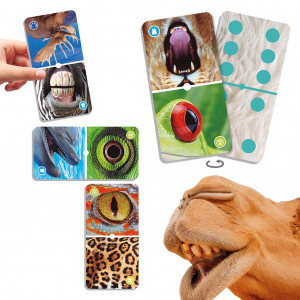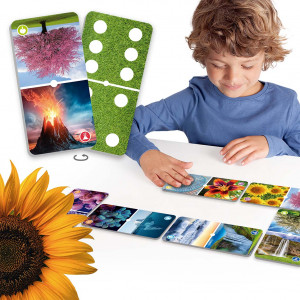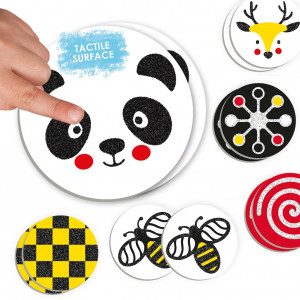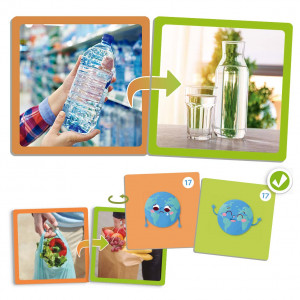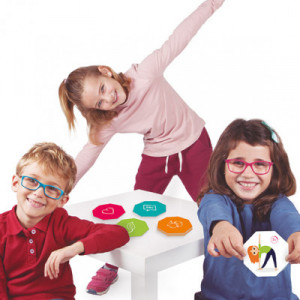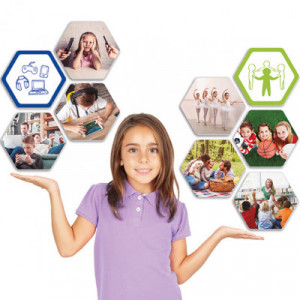Attention Deficit Hyperactivity Dis. (ADHD)
Attention Deficit Hyperactivity Disorder (ADHD) is a disorder characterized by difficulty in maintaining attention and may be accompanied by excessive activity and impulsivity.
Children with ADHD or ADHD have difficulty maintaining attention and following routines, guidelines and orders on an ongoing basis. That's why the best games are those that, in a fun way, awaken their curiosity, help them to fix the concentration, organize and memorize playing.
On the Akros website we have prepared a selection of observation puzzles, memorys, games to find the differences, bingo and fun activities that work on conflict resolution so that you can choose the most appropriate according to the characteristics and tastes of your child.
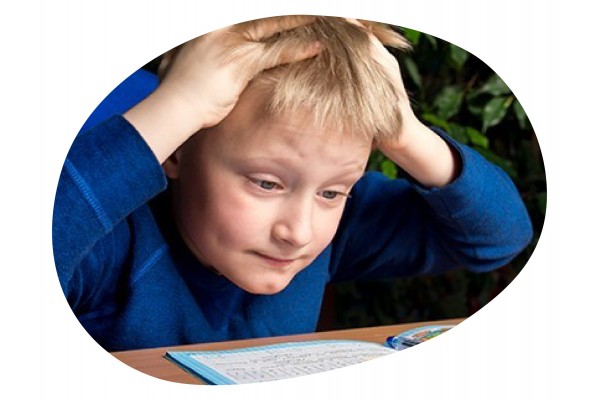
Games to improve the concentration of children with ADHD
Children with ADHD can train certain techniques to improve their ability to concentrate through educational activities and games. Symptom detection, diagnosis, information for adults and initiation of treatment should be as early as possible. As a reinforcement of treatment, parents should offer play to their child in a fun and engaging way.
Once their attention has been drawn, parents should explain the mechanics of the game to their child in an unambiguous way. Children with attention-deficit and hyperactivity disorder have difficulty thinking and planning, so they may need time and additional information to understand the task at hand, even if it means learning a game they like. The explanation of the rules should place special emphasis on the child's understanding that losing a game is part of the game, and not a tantrum situation.
The educational puzzles on the Akros website are an effective support in improving concentration. Depending on the child's tastes and needs, parents can offer to play word puzzles. These activities involve the construction of syllables, words or entire phrases; and there is the picture puzzle variant.
In the same way, the activities and games of completing geometric figures serve as reinforcement of the treatment of ADHD. Card games for finding differences or relating families of objects can improve memorization.
Other support games for the therapy of attention-deficit/hyperactivity disorders are those of the "connect the dots" type. In them the child must complete sequences of lines in a drawing.
What is ADHD?
ADHD or attention deficit hyperactivity disorder is a childhood disorder of neurobiological origin. The diagnosis of ADHD in children under the age of 6 is rare, as symptoms such as excessive impulsivity are evident in school settings. During primary school, the young person faces major situations and difficulties that may show that his or her ADHD goes beyond simple childhood concerns.
The illness can lead to other disorders that affect mental health. By the end of the school year, the adolescence of children with undiagnosed and untreated ADHD is often problematic, as is their life as adults. In the case of adults who take their child with ADHD to the specialist for consultation, it may happen that one of the parents discovers in their child's symptoms the same health problems that he or she had in childhood and did not receive diagnosis or treatment.
The treatment of ADHD, once the information on the case is collected, is planned on an individualized basis depending on the patient. The combination of pharmacological and psychological treatment mitigates symptoms and minimizes the occurrence of other associated mental health disorders. Treatment is similar in the more adult patients.
Signs of ADHD
The first signs of attention deficit may be noticed in school, as this is the place where children begin to interact, and where they begin to be required to follow social patterns outside of family dynamics.
For diagnosis, symptoms are grouped into three main behavior patterns: hyperactivity, impulsivity and attention deficit. Symptoms should persist for more than 6 months and be unusual for the child's age or intelligence level.
Hyperactivity
The child is restless, has trouble letting go of legs and hands or changes position constantly, gets up or has trouble sitting, is noisy when expected to be at the crook or during games that require concentration or silence, or in those where he or she must wait his or her turn.
Attention deficit
Makes mistakes that are not consistent with your intelligence, often carelessly; Has trouble or is unable to maintain attention to tasks or play. Often seems to not listen when spoken to; has trouble following instructions or completing activities or duties without being distracted or moving on to another task; is averse to duties that require more mental effort; loses tools, keys, or other objects of daily use; is easily distracted; and may forget activities of daily living.
Impulsivity
Responds arrogantly or prematurely, in group situations often skips shifts or loses patience while waiting; frequently interrupts or interferes with conversations or tasks of peers, talks a lot and without measures on social considerations.
Activities to treat impulsivity and improve self-control
- The volcano: we should ask the quiet child to visualize a volcano before it erupts and explain the metaphor so that he can identify his emotions with it. That way, when we see him getting angry, we can remind him of the volcano and make him aware of how his feelings can take over.
- The traffic light: works best with older children. As in the previous exercise, when the child is calm, we agree with him/her a series of signals that will help us to alert him/her to his/her level of nervousness. If we take the traffic light colors, green will tell you that everything is fine, yellow is starting to get hot and red has crossed the agreed boundaries.
- Relaxation methods: getting the child used to self-relaxing one or more times a day (e.g. before bedtime or at naptime) will contribute very positively to his or her mood. If you are a very young child, you can change your relaxation for soothing rituals, such as a hot bath, a story or a massage.
- Channel the energy: it is important that they can channel the surplus energy that they have... Thus, it is very beneficial that they can carry out some extracurricular sports activity in which they can release excess energy. However, at home they should also have a specific space where they can release that energy without harming themselves or others, where they can shout or strike if they wish.
- Enhance attention: Very impulsive children often have trouble concentrating. Games like chess or checkers are excellent options, as long as we are able to motivate the child to be attracted to them and play does not become an obligation.
Causes of Hyperkinetic Disorder
The causes of this disorder are unclear, but a combination of biological, psychological, and environmental factors may contribute to a change in the child's behavior as he or she leaves the family environment - which is always more controlled.
Biological factors include male relatives to grandparents and uncles who may show or have shown symptoms of ADD or ADHD during childhood; injuries acquired during pregnancy or birth, at which time they may be vulnerable to hypoxic injury (lack of oxygen to the brain and reduced blood flow), are among the causes that may generate psychological factors, along with the child's personality; and environmental factors could be related to family or school stress, or educational difficulties (low resources, schools far from home, high academic competence, absent parents, etc.).)
How is hyperkinetic disorder diagnosed?
The child psychologist must perform a series of tests and follow-ups before diagnosing a child with ADD or ADHD. Some of the procedures include:
- Family history evaluation: the mental and physical health of the child's parents and other family members, history of depression.
- Medical history: risk factors during pregnancy and childbirth. Any medications taken by the child or the mother during pregnancy may also be relevant.
- Symptoms: when symptoms were first noticed and in what situation they occurred, factors that aggravated or relieved them.
- Child's psychiatric history: exclude depression or anxiety after the onset of symptoms.
- Academic history: this indicates the level of your ability and specific difficulties in functioning as a group or individually.
- Assessment of the child's temperament and personality: includes assessment of the child's temperament and interrelationships, with family members and at school.
- Social Behavioral Assessment: Social conditions in the family, such as characteristics of the family nucleus, status, and social support, can have an impact on the child's behavior.
Treatments for attention deficit disorder
A combination of psychological treatment with family and academic dynamics is needed to help you change behavior and improve school performance. Treatment will depend on the difficulties of each individual child and their personal diagnosis. The incorporation of new routines and activities such as sports and music are essential to promote a change in their behaviour and the involvement of parents and family members in conjunction with teachers is essential. It is also very beneficial to interact in a playful way with the child with sensory games or puzzles that allow them to capture their attention and concentrate. Some medications may be suggested by the child psychiatrist, but it is essential to combine them with all other methods.
Psychological management
Therapies aimed at reducing anxiety and group therapies may be of great benefit and are often combined with therapies to improve social skills. Support in learning, to promote school performance and social integration will also need to be re-designed.
These behavior modification techniques are essential in the treatment of hyperkinetic disorder but may also be recommended for mild attention deficit problems.
Diet change
There is evidence about the effect of some foods on children, including sugar and excessive carbohydrate intake. Carefully observing whether behavior changes occur after eating specific foods is important, as well as observing allergic or other reactions to them. Such foods should be avoided. A specialist can help you choose a diet according to your age and rate of growth.
Stimulating medication
Medications may be prescribed in specific cases, but should be carefully monitored and combined with other therapies and learning models, as well as with sports and outdoor play activities.
It is important to explain to the child that medication is a palliative for the symptoms, but it is the enthusiasm and attitude itself, together with the family and school dynamics, that will actually produce a change in their behaviour and behaviour.
It is imperative to quickly address and eliminate stigma and misconceptions (such as letting him think that taking the pills makes him crazy, or makes him different).
Among the most commonly used medications are central nervous system stimulants, such as amphetamine derivatives, whose side effects can be significant. They are used to reduce hyperactivity and impulsivity and to improve care, but should be administered only under strict medical and family follow-up. No medications for this type of childhood disorder are recommended for children under 6 years of age.
Driving techniques for parents and teachers
Routines and planning play an important role, considering strategies to address:
- Daily routines.
- Establishing rules.
- Clarity in explaining things or giving instructions.
- Coherence in the treatment of children.
- Limit the elements of distraction.
- Task planning.
- Personalised treatment of children, promoting integration with other children.
- Recognition of good behavior.
- Sanctioning bad behavior (never physical but through deprivation of other pleasures using a strict process of negotiation or exchange of: pleasure for good behavior).
- Work in coordination with the school and teachers to maintain these patterns and not to substitute or omit the agreements established in each context.
Symptoms of Attention Deficit Disorder without Hyperactivity
This disorder can only be diagnosed from the age of five or six, but it is from the age of three that a professional with sufficient experience will be able to detect the first symptoms.
The symptoms of attention deficit disorder without hyperactivity are detectable from the moment we see that the child does not adapt correctly to the different areas of daily life, i.e. family, school, friends and even himself.
- Moves excessively slowly, in all areas, dressing, eating, walking, etc.
- They are unable to detect what are the important or most significant details of a context or situation they are presented with.
- They are constantly distracted, always abstracted and have difficulty directing attention to what they are told.
- The tasks they do are done in a longer time than expected, they are slow to think about certain things and to do those things.
Until ADD is detected and diagnosed, it is thought that children do not do things because they do not want to, that they are lazy, lazy, etc., and it is normal for them to be punished for it.
Parents, teachers, friends, siblings, etc., can all reprimand a child with ADHD for not doing things as expected, which only increases the fear and frustration that the child may feel.
Lack of attention, or rather of effective attention, means that everything related to learning is affected.
Children with ADD often lose objects such as toys, books, school supplies, etc., and often do not remember where they were left.
Common Characteristics of Attention Deficit Disorder with and without Hyperactivity Disorder
Despite the large differences between children with and without hyperactivity with this disorder, we can find many common characteristics that we explain below:
- Children tend to have low self-esteem.
- They are introverted and apathetic.
- They can't wait their turn.
- They insist on getting what they want.
- They are disorganized
- They are unpunctual
- They are stubborn
- They are inattentive
- Have tantrums
- Etc.
ADD with Hyperactivity
Children with Attention Deficit Hyperactivity Disorder (ADHD) generally suffer from other symptoms and disorders associated with hyperactivity and impulsivity.
The motor, mental and emotional control of a child with ADHD is characterized primarily by:
- Unrest, nervousness, restlessness,...
- Hyperactivity
- Dysgraphia or difficulty reproducing both letters and words
- Incompetence
- Gives quick answers without thinking
- Lack of attention
- Lack of effectiveness
In addition, children with ADHD are impulsive, impatient and self-centered.
ADD without Hyperactivity
It is less common than ADHD and in this case, this disorder is characterized by the exact opposite of the previous one:
- Passivity
- Drowsiness
- Slowness
- Lack of energy and vitality
In general, children with attention-deficit/hyperactivity disorder (ADHD) are children who are withdrawn, unable to attend, unable to maintain attention for very long periods of time, and have trouble getting their attention right.
The child with Attention Deficit Disorder without hyperactivity usually has somewhat childish behaviors, immature in relation to those expected due to his or her stage of maturation.
In addition, in terms of their motor control, they tend to present passivity, slowness, dysgraphia and clumsiness that are accompanied by slow responses, disorganization and, in general, inefficiency in the performance of their tasks.
Treating Attention Deficit Disorder
- Speak directly to the eyes, slowly and gently, but with firmness, and get the child to repeat what has been said.
- Split up tasks so that they can be better assimilated. In class you should sit in the front row, close to the teacher, and at home we should remove all distractions from your sight.
What should not be done is to punish the child who suffers from this type of distraction but to motivate him or her to manage to regulate his or her attention.


















